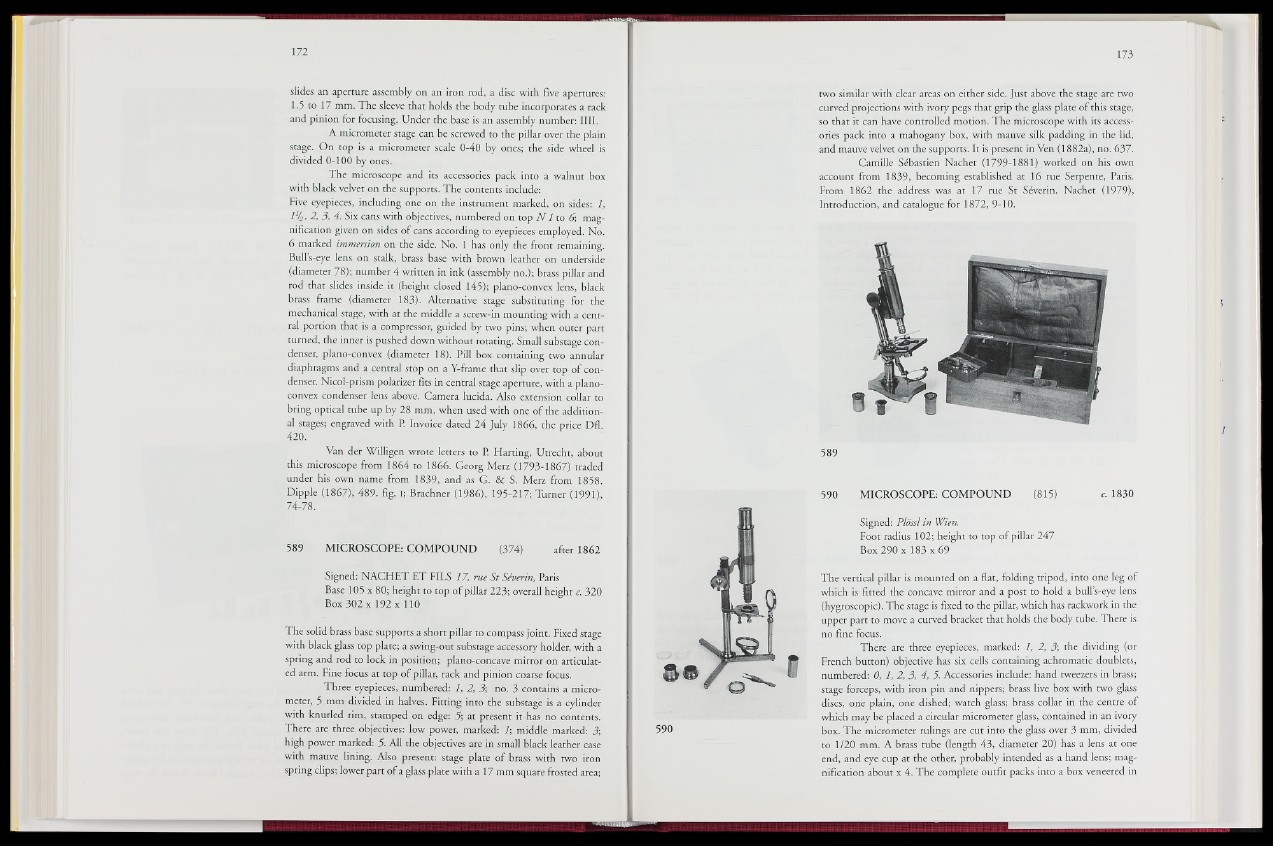
slides an aperture assembly on an iron rod, a disc with five apertures:
1.5 to 17 mm. The sleeve that holds the body tube incorporates a rack
and pinion for focusing. Under the base is an assembly number: IIII.
A micrometer stage can be screwed to the pillar over the plain
stage. On top is a micrometer scale 0-40 by ones; the side wheel is
divided 0-100 by ones.
The microscope and its accessories pack into a walnut box
with black velvet on the supports. The contents include:
Five eyepieces, including one on the instrument marked, on sides: 1,
I /2, 2, 3, 4. Six cans with objectives, numbered on top N 1 to 6-, magnification
given on sides of cans according to eyepieces employed. No.
6 marked immersion on the side. No. 1 has only the front remaining.
Bull’s-eye lens on stalk, brass base with brown leather on underside
(diameter 78); number 4 written in ink (assembly no.); brass pillar and
rod that slides inside it (height closed 145); plano-convex lens, black
brass frame (diameter 183). Alternative stage substituting for the
mechanical stage, with at the middle a screw-in mounting with a central
portion that is a compressor, guided by two pins; when outer part
turned, the inner is pushed down without rotating. Small substage condenser,
plano-convex (diameter 18). Pill box containing two annular
diaphragms and a central stop on a Y-frame that slip over top of condenser.
Nicol-prism polarizer fits in central stage aperture, with a planoconvex
condenser lens above. Camera lucida. Also extension collar to
bring optical tube up by 28 mm, when used with one of the additional
stages; engraved with P. Invoice dated 24 July 1866, the price Dfl.
420.
Van der Willigen wrote letters to P. Harting, Utrecht, about
this microscope from 1864 to 1866. Georg Merz (§93-1867) traded
under his own name from 1839, and as G. & S. Merz from 1858.
Dipple (1867)1489. fig. I; Brachner (1986), 195-217; Turner (1991),
74-78.
589 MICROSCOPE: COMPOUND (374) after 1862
Signed: NACHET ET FILS 17, rue St Severin, Paris
Base 105 X 80; height to top of pillar 223; overall height c. 320
Box 302 x ® 2 x 110
The solid brass base supports a short pillar to compass joint. Fixed stage
with black glass top plate; a swing-out substage accessory holder, with a
spring and rod to lock in position; plano-concave mirror on articulated
arm. Fine focus at top of pillar, rack and pinion coarse focus.
Three eyepieces, numbered: 1, 2, 3; noSfgtontains a micrometer,,
5 mm divided in halves. Fitting into the substage is a cylinder
with knurled rim, stamped on edge: 5; at present it has no contents.
There are three objectives: low power, marked: 1; middle marked:!!!
high power marked: 5. All the objectives are in small black leather case
with mauve lining. Also present: stage plate of brass with two iron
spring clips; lower part of a glass plate with a 17 mm square frosted area;
two similar with clear areas on either side. Just above the stage are two
curved projections with ivory pegs that grip the glass plate of this stage,
so that it can have controlled motion. The microscope with its. access-
'ories pack into a mahogany box, with mauve silk padding in the lid,
and mauve velvet on the supports. It is present in Ven (1882a), no. 637.
Camille Sébastien ‘Nachet (1799-1881) worked on his own
account from 1839, becoming established at 16 rue Serpente, Paris.
From 1862. the address was at 17 rue St Séverin. Nachet (1979),
Introduction, and catalogue for 1872, 9-10.
589
590 MICROSCOPE: COMPOUND (81,|| c. 1830
Signed: Pl$m in Wien.
Foot radius 102; height to top of pillar 247
Box 290 x 183 x 69
The verti®! pillar is mounted on a flat, folding tripod, into one leg ®
which is fitted the concave mirror and a post to hold a bull’s-eye lens
(hygroscopic). The stage is fixed to the pillar, which has rackwork in the
upper part to move a curved bracket that holds the body tube. There is
no fine focus.
There are three eyepieces, marked: 1, 2, 3; the dividing (or
|||: French button) objective has six cells containing achromatic doublets,
numbered: 0, 1, 2, 3, 4, 5. Accessories include: hand tweezers in brass;
stage forceps, with iron pin and nippers; brass live box with two glass
discs, one plain, one dished; watch glass®Eass collar in the centre of
which may be placed a circular micrometer glass, contained in an ivory
box. The micrometer rulings are cut into the glass over 3 mm, divided
to 1/20 mm. A brass tube (length 43, diameter 20) has a lens at one
end, and eye cup at the other, probably intended as a hand lens; magnification
about x 4. The complete outfit packs into a box veneered in